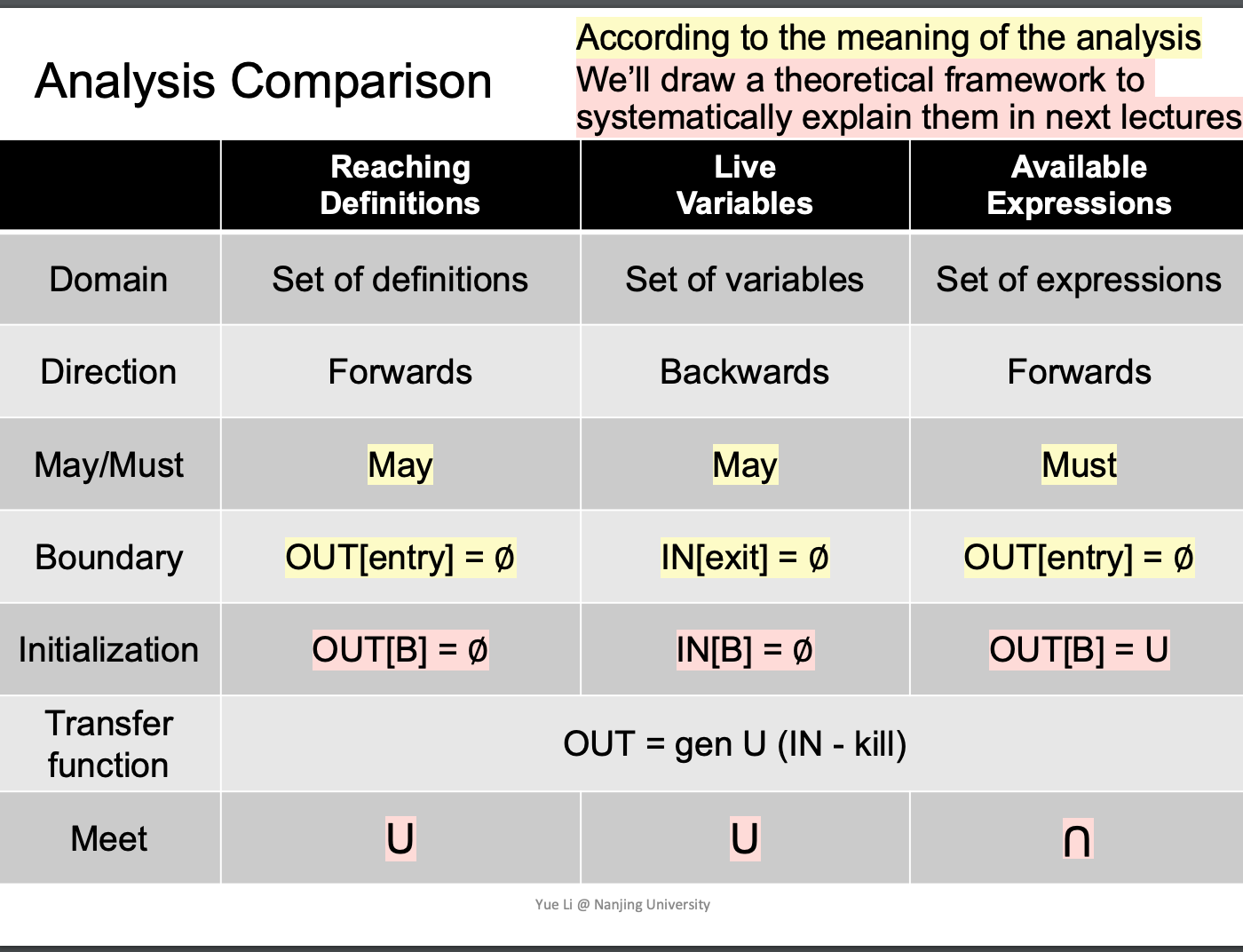Data Flow Analysis:Applications
Overview
What is Data Flow Analysis ?
How application-specific Data flows on CFG with safe approximation.
分析算法感兴趣的数据如何流经控制流图。
- CFG
- Nodes (Basic Blocks) 基本块
- Edges (Control Flow) 控制流
- CFG(a program) 整个程序
- Safe Approximation
safe approximation for different purposes 不同的分析目的,对于safe有不同的定义:
- Must Analysis:Under Approximation
- May Analysis: Over Approximation
相同点:这两种目的往往殊途同归地达到Soundness。
不同的目的对应了不同的手段:1. Data Abstraction 2. Approximation Strategies i.e. transfer functions & control flow handling.
Preliminaries for Data Flow Analysis
Input & Output States
Definition:
$IN[s]\ OUT[s]$ stand for input & output states of program points i.e. before and after executing the IR statements $s$ respectively.
e.g.:
- 下面是最简单的程序点的示意图。包括:
- $s_1$的输入/输出状态
- $s_1$的语句
- 程序点,包括状态信息
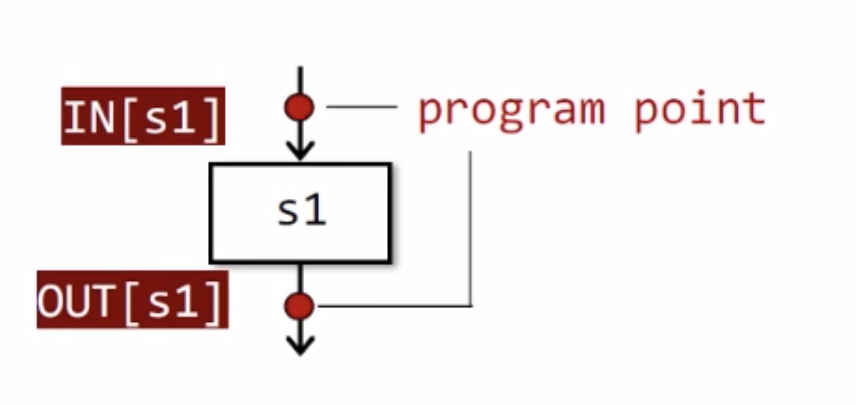
语句之间的状态关系1:
下面表示两个顺序的语句之间状态关系。
即,$s_2$的输入是$s_1$的输出
$IN[s_2]=OUT[s_1]$

带有控制流的语句间的状态关系1:
右图表示了一种分支语句的状态关系
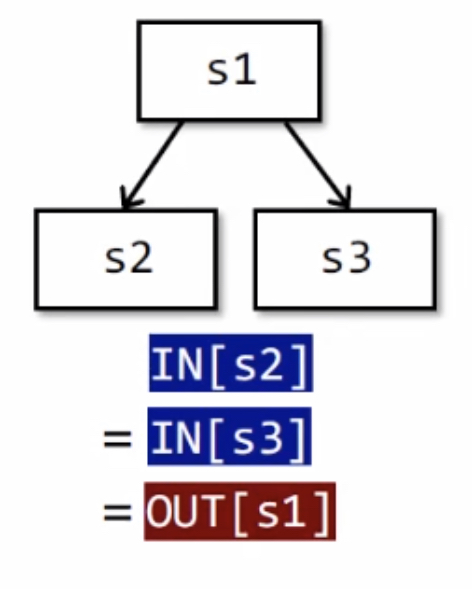
带有控制流的语句间的状态关系2:
下图是分支合并语句的状态关系,引入了操作符$\wedge$,表示语句分支的合并

Domain 值域
In each data-flow analysis application, we associate with every program point a data-flow value that represents abstraction of the set of all possible program states that can be observed for that point.
data-flow value: Abstraction of the set of all possible program states that can be observed for that point.
于是,我们把 data flow value在一个程序中可能取值的集合称作 Domain.
Data flow analysis: another perspective
Data-flow analysis is to find a solution to a set of safe-approximation-directed constraints on the $IN[s]$ and $OUT[s]$, for all statements $s$.
- constraints
- transfer functions
- flow of control
- solution
- related data flow value for each program points of statement $s$.
Notations for Transfer Functions’s Constrains
- Forward Analysis
$OUT[s] = f_s(IN[s])$
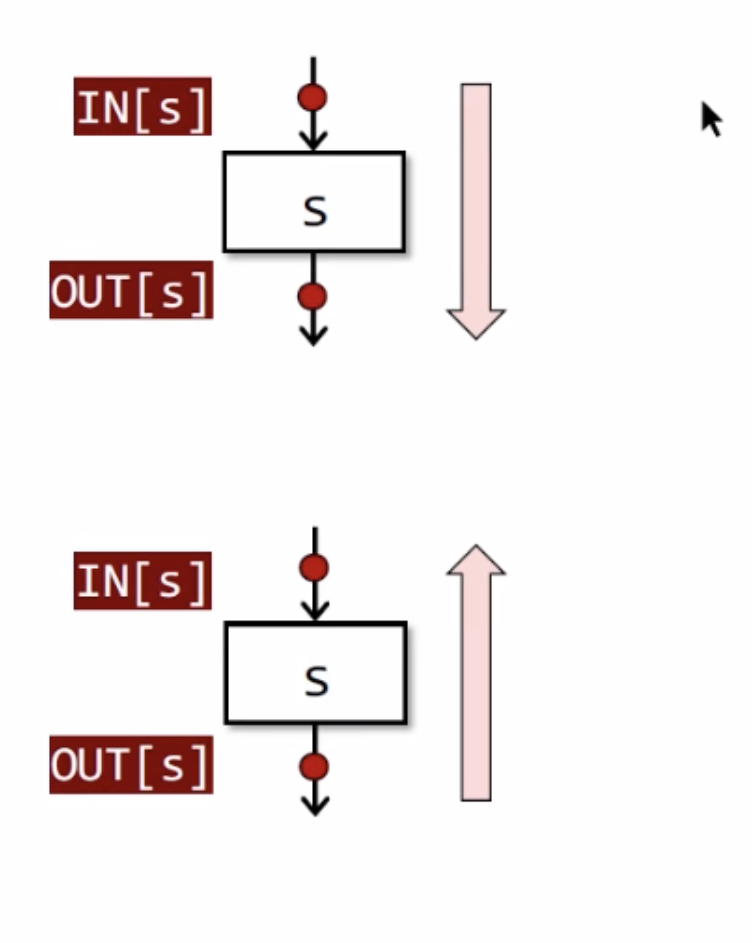
- Backward Analysis
$IN[s] = f_s(OUT[s])$
Notations for Control Flow’s Constraints
Control flow within a BB
$IN[s_{i+1}]=OUT[s_i], \forall i=1,2,3,…,n-1$
Control flow among BBs
$IN[B] = IN[s_1]$
注:BB的入口是BB第一个语句的入口
$OUT[B]=OUT[s_n]$
注:BB的出口是BB最后一个语句的出口
$OUT[B] = f_B(IN[B]), f_B = f_{sn} \circ … \circ f_{s2} \circ f_{s1}$
注:$\circ$ 表示函数的复合
$IN[B]=\bigwedge_{\color{red}P\\ a\ predecessor\ of\ \color{blue} B}^{} OUT[P]$
注:分支合并B的输入等于B所有前驱节点输出状态 meet 的结果
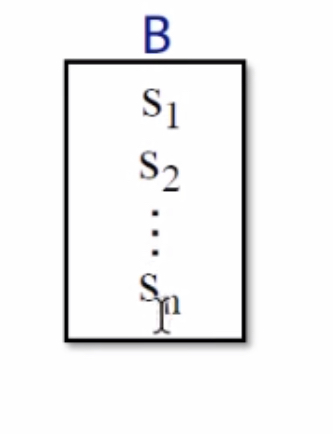
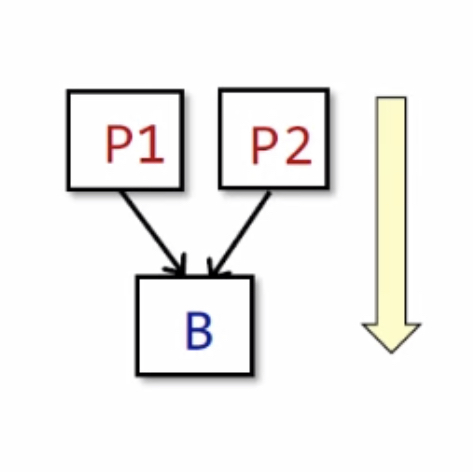
Reaching Definitions Analysis
Definition:
A statement that assign a value to $v$. 一条对$v$的赋值语句。
Reaching Definition:
Definition of variable $v$ at program point $p$ reaches point $q$ if there is a path from p to $q$ s.t. no new definition of $v$ appears on that path.
Reaching Definition:变量$v$在从程序点$p$到程序点 $q$到过程中未被重新定义。
应用
Detecting possible undefined variables. 检查undefined变量
E.g.: Introduce a dummy definition for each variable. If any at point $p$, definition of variable $v$ is dummy, then it is undefined.
e.g.: Application in Optimization: Check if the variable
Abstraction
Data Flow Values / Facts
- The definition of all the variables in a program.
- represented by Bit Vectors
e.g.: $D_1, D_2, D_3, …, D_{100}$ (100 definitions)
[ 0000...0 ] <——(100 bits)Bit $i$ from the left represents definition $D_i$
Safe-Approximation
考虑语句:
D: v = x op y
本条语句将程序中 $v$ 的其他定义去除,其他变量的定义不受影响。
Transfer function 数学语言表达
$$OUT[B] = gen_B \cup (IN[B] - kill_B)$$
其中$gen_B$基本块$B$产生的definition的集合
$kill_B$代表所有$B$以外基本块对$B$内变量的更改语句的集合
Control Flow
- 是 Forward Analysis,算法从Entry 跑到Exit
- 由于是 May Analysis,因此不会忽略任意一个分支
$$IN[B] = \bigcup_{P\ a\ predecessor \ of\ B} OUT[P]$$
下图是龙书上 $gen_B$ 和 $kill_B$ 的例子
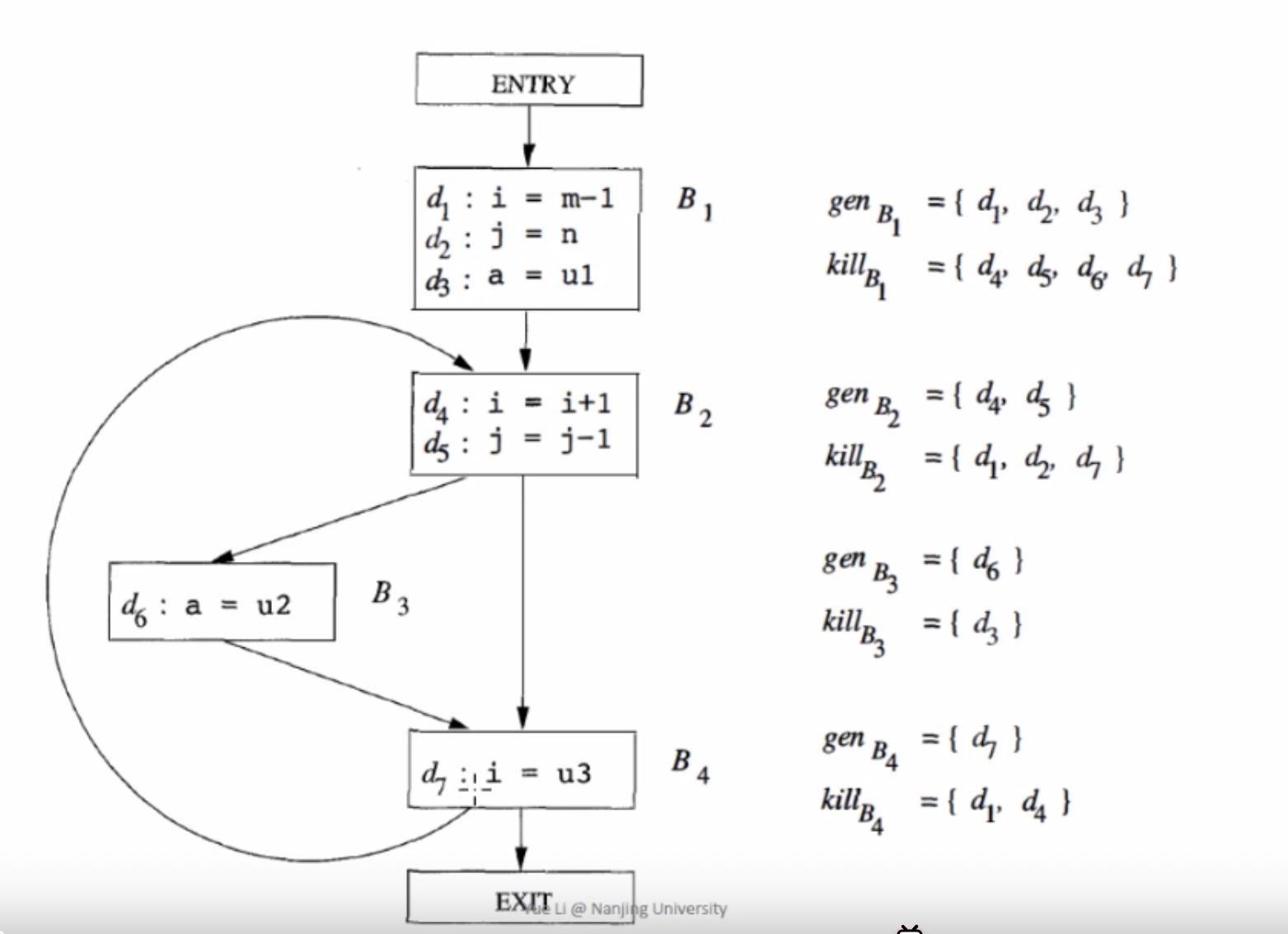
Algorithm of Reaching Definition Analysis
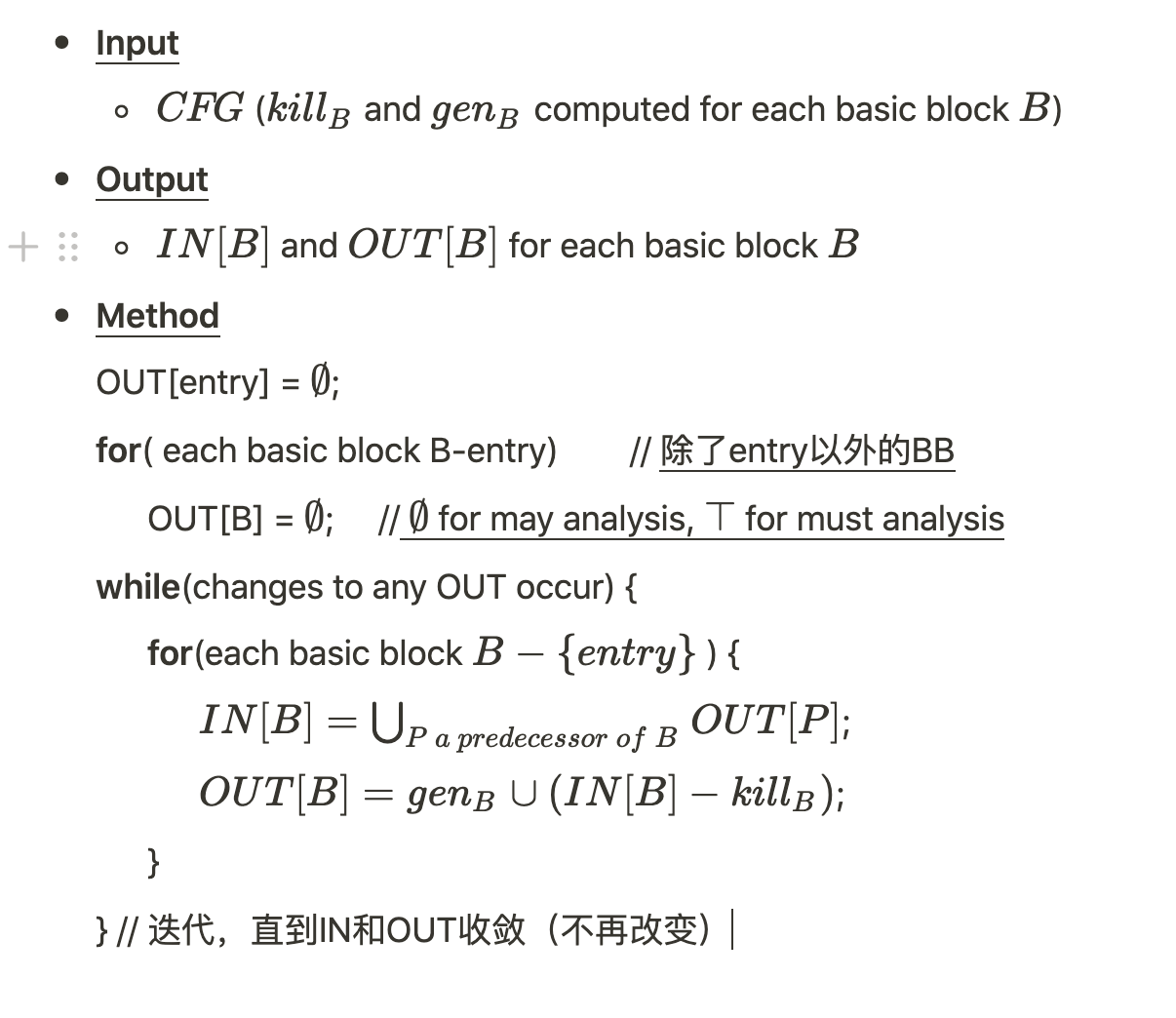
练习题
- 练习: 对以下CFG执行 **Reaching Definition Analysis,**给出最终的$IN$和$OUT$
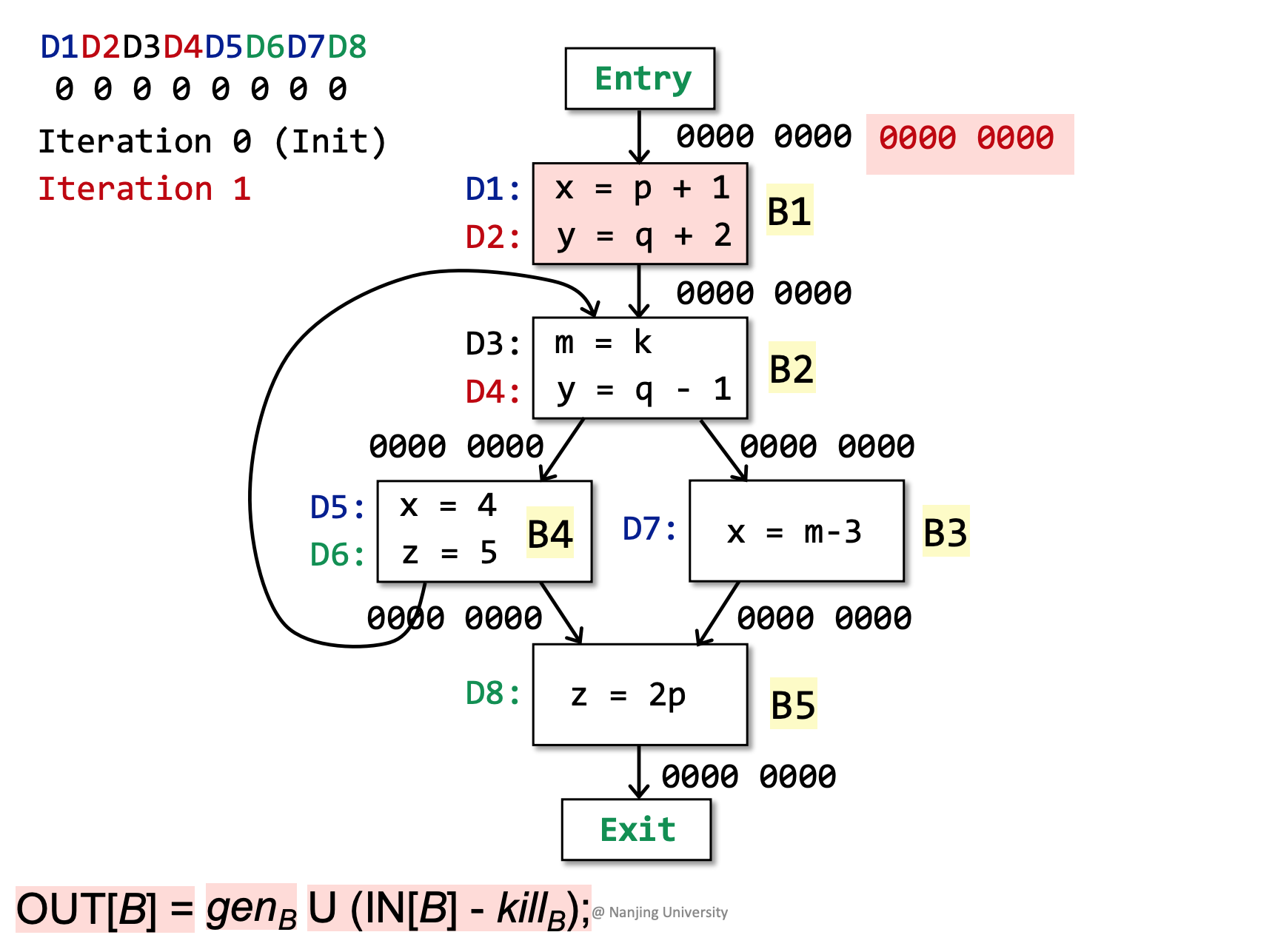
Understanding the why the loop will definitely stop (理解算法的收敛性)
$gen_s$ 和 $kill_s$ 是常量
$IN[s]$ 每次增加的因子factor(这里指Definition)要么被$kill_s$ 要么被带入$OUT[s]$

- 于是$OUT[s]=f_s(IN[s])$ 单调不减 ($OUT[s]$要么0→1, 要么 1→1 )
- 又由于factor本身是有限的 i.e. OUT[s]最多变成 1111…1111 就不变了。
- 类比一下数列的单调有界准则。
Understanding the safe-approximation (理解算法安全近似性)
当$OUT[s]$不再变化时,$IN[s]$是否会再次变化?
答案是不会,由于
$IN[B] = \bigcup_{P\ a\ predecessor \ of\ B} OUT[P]$
所有的$IN[B]$ 取决于 $OUT[P]$ 的值,于是$IN[B]$的值不变。
$OUT[B] = gen_B \cup (IN[B] - kill_B)$
于是所有的 $OUT[s]$也不会改变。
练习:对以下CFG,利用Reaching Definition Analysis,计算各个BB最终的$IN$和$OUT$
Live Variable Analysis
Definition:
Live variable analysis tells whether the value of variable $v$ at program point $p$ could be used along some path in CFG starting at $p$. If so, $v$ is live at $p$;otherwise,$v$ is dead at $p$.
(这也意味着:$v$ should not be redefined before usage)
- Application:
- Register Allocation (寄存器分配)
Abstraction
- Data Flow Values/Facts
- All the variables in a program
- Can be represented by bit vectors
- 0: dead 1: live
Safe-Approximation
why forward analysis is not appropriate for live variable analysis?
- Assume we use forward analysis strategy, information of using should be propagate backward whenever a statement use $v$ is reached, which costs a lot.
- 我们利用反证法的思想:假设我们使用前向分析,变量使用的信息将会被向后传播,那还不如直接进行后向分析来的方便。
According to the definition, the live variable should be a may analysis.
understand the term ‘live’: determine whether the variable $v$ in some register $R$ is live, or should we delete the value of $v$ in $R$, at the point of $IN[B]$?
If Yes, $IN[B] = {v}$ else $IN[B] = {}$
由于是may analysis,Control Flow通过以下式子给出
$$ OUT[B] = \bigcup_{S\ is\ a successor\ of\ B} IN[S] $$

盲人摸象:我们通过以下一组练习,探索所有B关于$v$的表达式之情况,来探索出 Transfer Function
练习:根据上图的CFG,并给定$OUT[B] = {v}$,考虑以下$B$的表达式对应的$IN[B]$
k = n2.k = v3.v = v - 14.v = 2; k = v5.k = v; v = 26.v = 2
*答案:
k = n: 由于没有涉及到$v$,根据原则,寄存器$R$不应删去$v$的值,因此$IN[B] = {v}$k = v: 由于涉及到use $v$,我们不应该删去$v$的值,因此$IN[B] = {v}$v = v - 1: 这题看似是对 $v$进行了新的定义,但是就语义而言,将会先对$v$的旧值进行读取,于是我们没有必要 kill 掉$v$,因此 $IN[B] = {v}$v = 2; k = v:这题看似使用了 $v$,但是先kill掉了$v$的定义,因此 $IN[B] = {}$k = v; v = 2:*正好与上题相反,先对$v$进行了use,因此$IN[B] = {v}$v = 2:$v$被kill掉,显然 $IN[b] = {v}$
先来回答集合中那些增减的量
- $use_B$:集合中在任何use先于define的变量集合。
- $def_B$:集合中任何define先于use的变量集合。
于是,我们可以摸索出一个 Transfer Function
$$ IN[B] = use_B \cup(OUT[B]-def_B) $$
思考:kill $def_B$ 和 union $use_B$ 的顺序是否影响算法的正确性?
结论:不影响,直觉上来看,根据$def_B$和$use_B$的定义,$def_B \cap use_b = \phi$
不失严谨地,我们可以证明这个性质:
【推论】
已知 $def_B \cap use_b = \phi$, $IN[B] = use_B \cup(OUT[B]-def_B) = (OUT[B] \cup use_B) - def_B$ 成立
【证明】
考虑集合运算公式: $(B-A) \cup C = (B\cup C) - (A - C)$
我们有:
$$ IN[B] = use_B \cup(OUT[B]-def_B) = (use_B \cup OUT[B]) - (def_B - use_B) $$
由于 $def_B \cap use_b = \phi$,于是有$def_B-use_B =def_B$
那么,
$$ (use_B \cup OUT[B]) - (def_B - use_B)=(use_B \cup OUT[B]) - def_B $$
$\blacksquare$
Algorithm
按照Reaching Definition Analysis的框架,不难得到。但是有一点不同:
由于是BackWard Analysis,从Exit节点开始遍历。
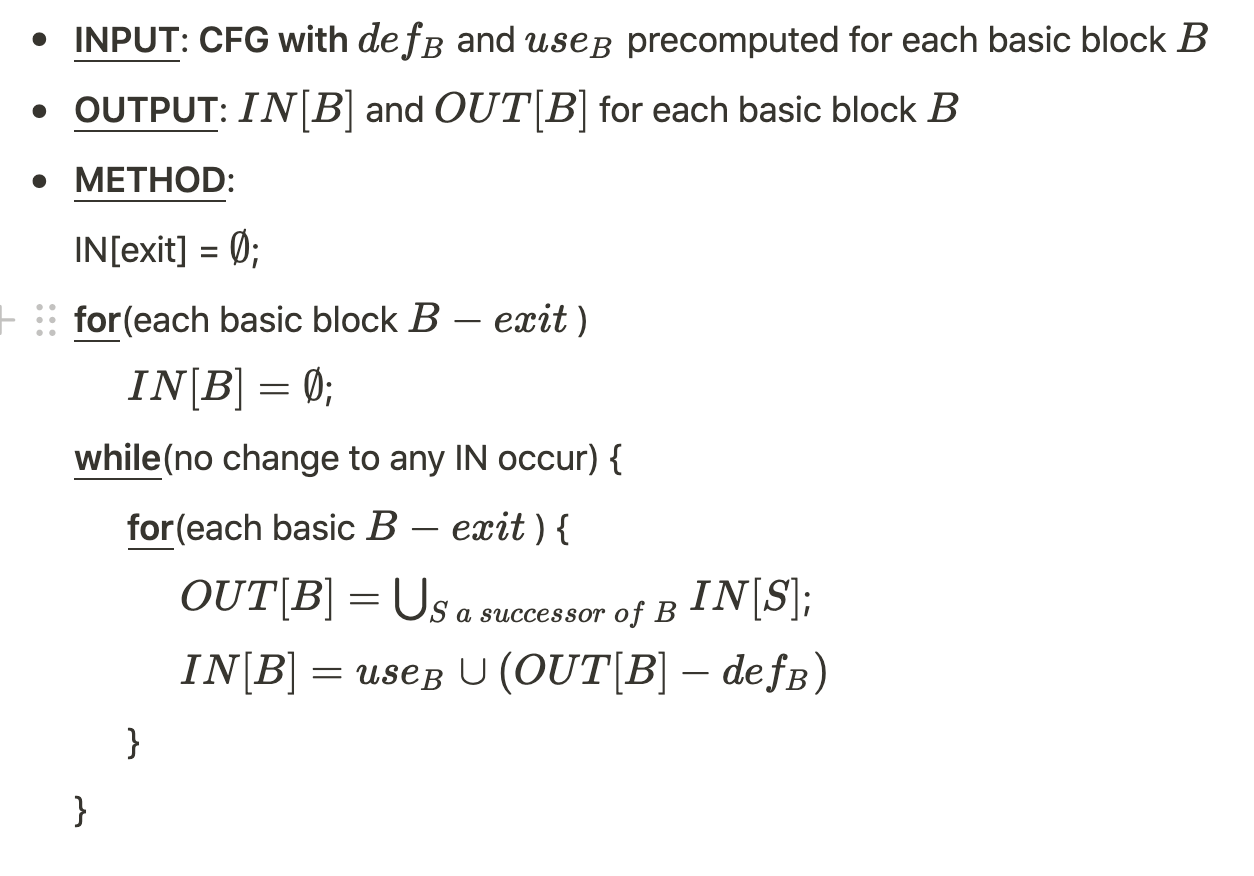
练习题
- 练习: 对以下CFG执行 **Reaching Definition Analysis,**给出最终的$IN$和$OUT$
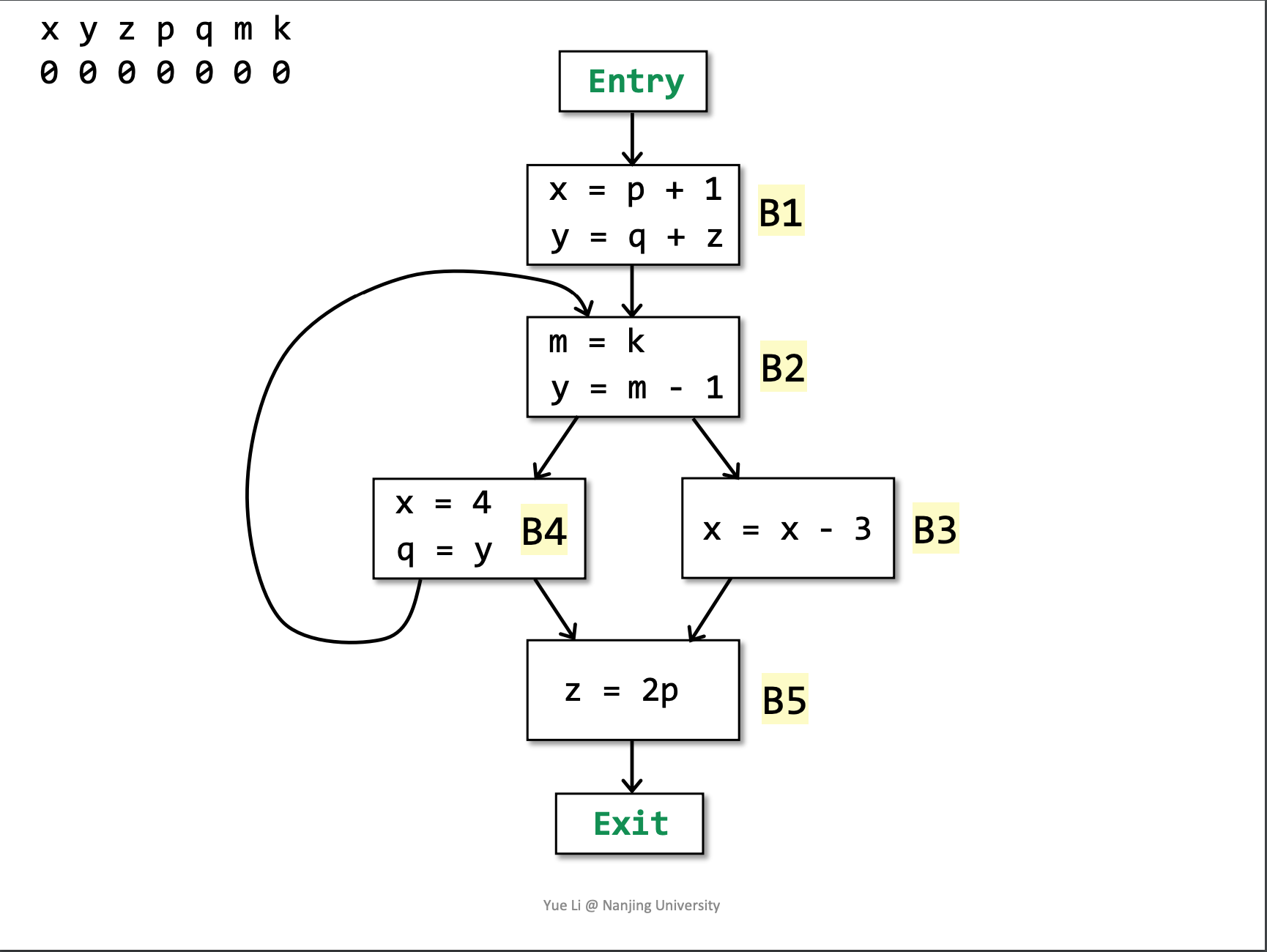
Available Expression Analysis
Definition
Available:
An expression x op y is available at program point $p$ if
- All paths from the entry to p must pass through the evaluation of
x op y - After the last evaluation of x op y, there is no redefinition of
xory
Explanation:
- 这里的redefinition表明:原本的结果失效,我们可以需要更改
x op y的结果值 - available expression的信息可以用于检查全局相同的子表达式
- 比如,在某几个BB中表达式的值不变,我们就可以删去那个表达式,直接将缓存的结果赋给变量,优化掉重复计算。
Abstraction
- All the expressions in a program
- Also represented by Bit Vectors
Safe-Approximation
注:
- As the definition illustrated, the available expression analysis ought to be a MUST ANALYSIS.
- As we are analyzing expression in all control flows, forward analysis is preferred to bring the information.
Transfer Function
$gen_B$: Any expression included by $B$ to be involved.
$kill_B$: Any expression contains variables redefined in $B$ to be excluded.
我们可以得到Transfer Function:
$$ OUT[B] = gen_B \cup (IN[B]-kill_B) $$
Control Flows
For it is a must analysis, control flow ought to defined by:
$$ IN[B] = \bigcap_{P\ predecessor\ of\ B } OUT[P] $$
Algorithm
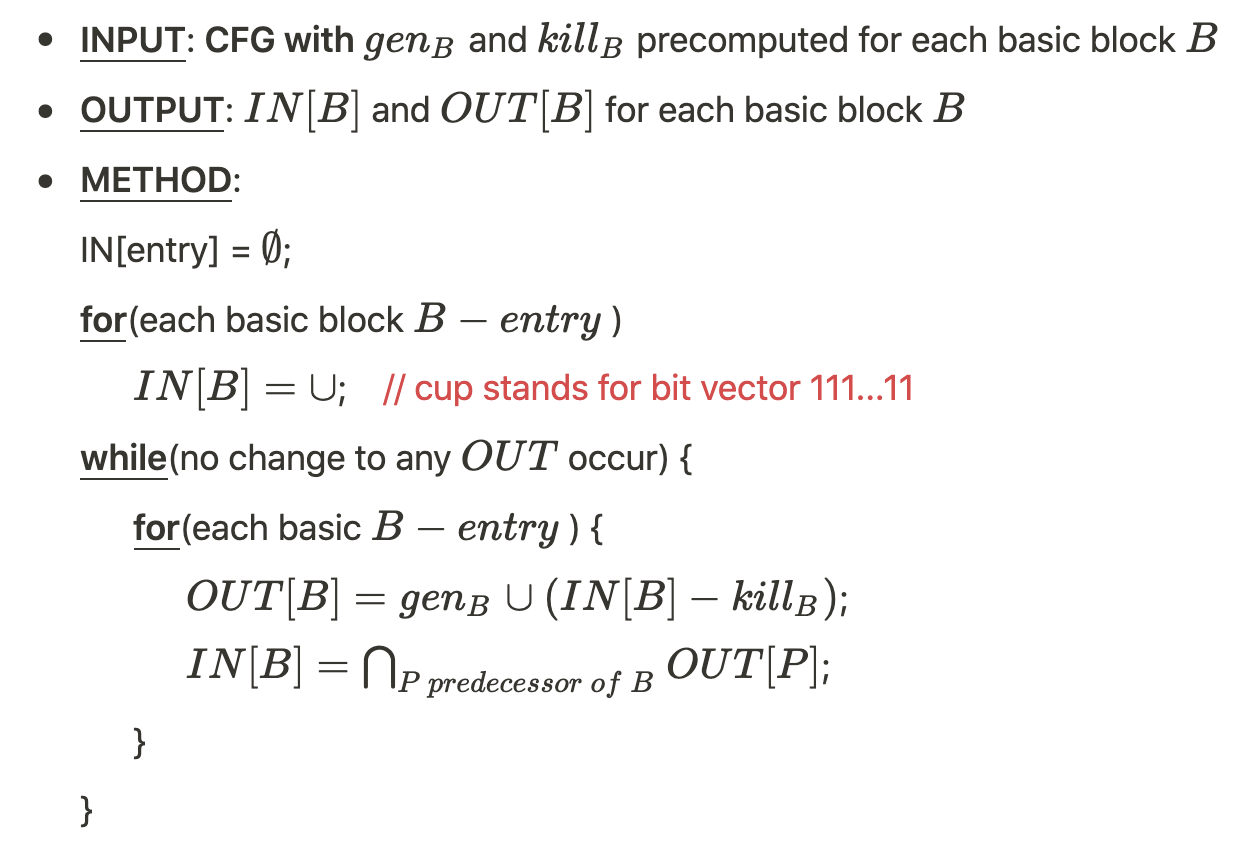
- 练习: 对以下CFG执行 **Reaching Definition Analysis,**给出最终的$IN$和$OUT$
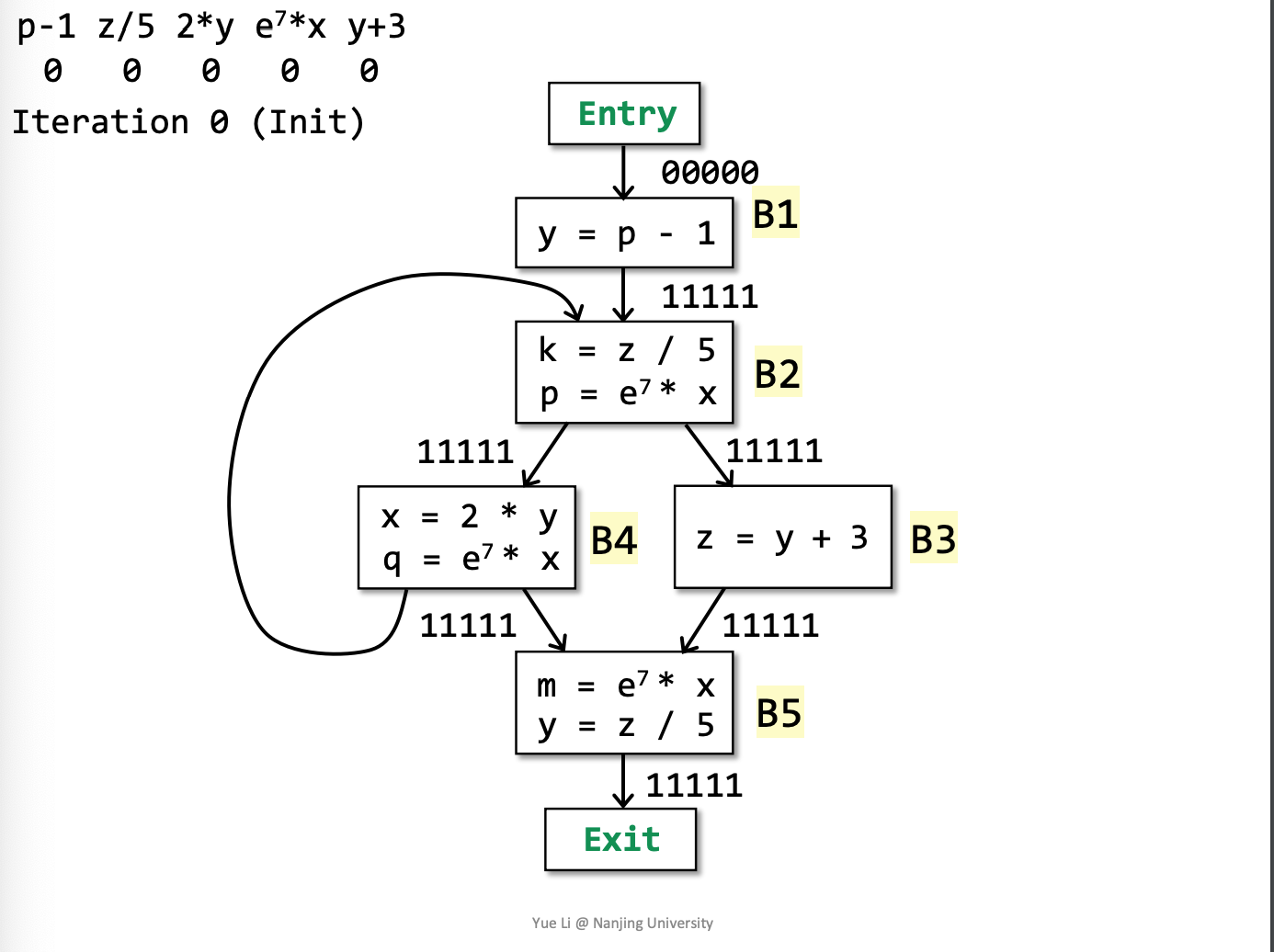
Comparison for three data flow analysis
练习:根据以上的内容,填写下表(不要参考上面的材料)
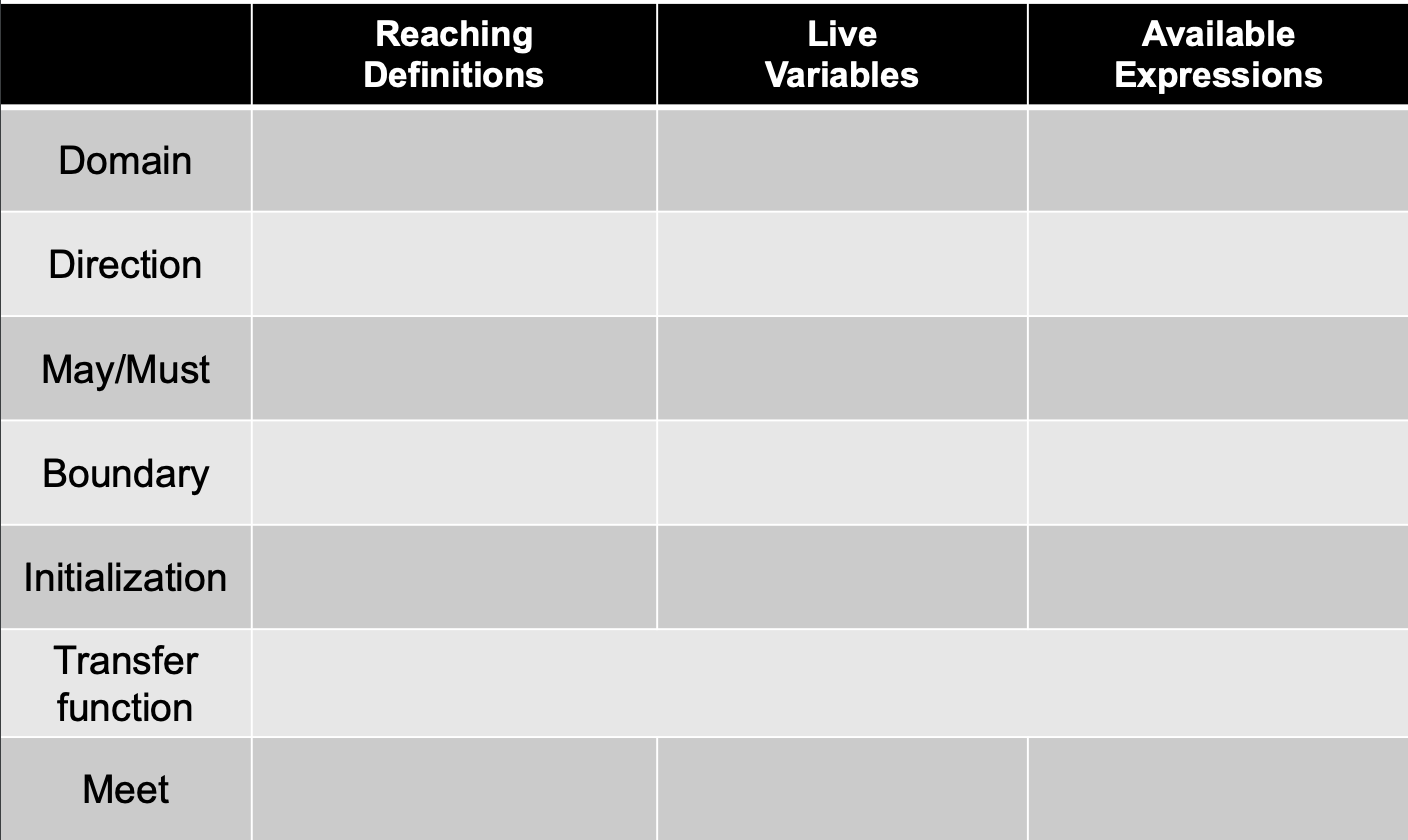
- 答案:
